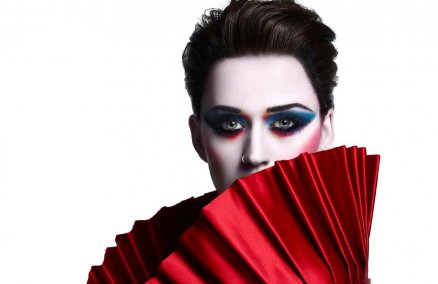Mythical Reality is completely different from your old landscape paintings. Why is that?
The title comes from two ideas: mythology and truth. I realized that people don’t really question why things are the way they are. The truth is a myth. All ideas, all beliefs, all the things we believe to be true are not really timeless, universal truths, no matter what we’ve been told. I started producing these paintings as a way of releasing my internal frustration with the state of things in our society today. People don’t try to think beyond what they’re presented with, and that’s part of the reason why there’s so much tension in society. The paintings were done to get people to see the condition that we’re in, and question reality.
Is that your specific message to the audience: question your beliefs?
Not necessarily. There is this saying that your thought process finishes once you’re done with your creation. It’s like [Roland Barthes’] Death of the Author. The audience gets to interpret the rest of the story, and, of course, there is absolutely no need to think like the creator. You shouldn’t force anyone to restrict their beliefs—everything is a human creation, be it religion, traditions or political ideology. That’s the whole point—people shouldn’t believe in an idea without knowing how it came about.
What makes a good artist?
A good artist must be open-minded. They must be willing to explore the world, and care about the outside world beyond the confines of the studio. It’s not enough that you have painting skills, you have to be able to think in order grow as an artist, and to create something new and meaningful. I stopped painting for years just so I could read more: history of art, philosophy or politics.
Why do photorealistic paintings if we can already produce such images using cameras?
The development of photography saw people move away from realistic paintings; artists had to change their brush strokes and differentiate themselves from photographers. For me, though, I feel the technology just allows you to play with images, use them as a base from which to experiment, to create something that’s understandable by the audience, yet also meaningful with a hidden message. That’s how I see my work.
What would you say to aspiring artists who are put off by the idea of doing fine art for a living?
Just like any art student, I didn’t think that I would continue painting after I graduated. I got into fine art because I liked drawing cartoons as a boy. Universities produce great artists but the market is extremely limited. You have to be very sure that this is what you want to do, and you will have to work hard to survive. Even working on this project was a big struggle for me. Whoever says that you can just be confident about you work and the rest will follow isn’t being honest.
Any future projects?
These 13 paintings took me over two years to complete. I didn’t even think that they would get shown to the public initially because this is a completely new style of work. My next set of paintings will not be as dark as this collection. Gray is something vague and in between, something that’s neither right nor wrong, good nor bad.















